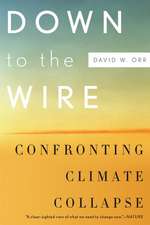Pollution Control Instrumentation for Oil and Effluents
Autor H. Parker, G.D. Pitten Limba Engleză Hardback – 31 oct 1987
| Toate formatele și edițiile | Preț | Express |
|---|---|---|
| Paperback (1) | 952.09 lei 6-8 săpt. | |
| SPRINGER NETHERLANDS – 26 sep 2011 | 952.09 lei 6-8 săpt. | |
| Hardback (1) | 958.25 lei 6-8 săpt. | |
| SPRINGER NETHERLANDS – 31 oct 1987 | 958.25 lei 6-8 săpt. |
Preț: 958.25 lei
Preț vechi: 1168.60 lei
-18% Nou
Puncte Express: 1437
Preț estimativ în valută:
183.35€ • 191.46$ • 151.41£
183.35€ • 191.46$ • 151.41£
Carte tipărită la comandă
Livrare economică 15-29 aprilie
Preluare comenzi: 021 569.72.76
Specificații
ISBN-13: 9780860103684
ISBN-10: 0860103684
Pagini: 432
Ilustrații: XVIII, 432 p.
Dimensiuni: 155 x 235 x 25 mm
Greutate: 0.81 kg
Ediția:1987
Editura: SPRINGER NETHERLANDS
Colecția Springer
Locul publicării:Dordrecht, Netherlands
ISBN-10: 0860103684
Pagini: 432
Ilustrații: XVIII, 432 p.
Dimensiuni: 155 x 235 x 25 mm
Greutate: 0.81 kg
Ediția:1987
Editura: SPRINGER NETHERLANDS
Colecția Springer
Locul publicării:Dordrecht, Netherlands
Public țintă
ResearchCuprins
1 Introduction.- 1.1 Background.- 1.2 The role of IMO and the progress of Marine Pollution Legislation.- 1.3 Oil Sources and Marine Transportation for Hydrocarbons.- 1.4 Operational Discharges at Sea.- 1.5 Fate and Environmental Impact of Oil Discharges at Sea.- 1.6 Scope of the Book.- References.- 2 Oil pollution control and international legislation.- 2.1 Introduction.- 2.2 The Development of MARPOL 73/78.- 2.3 Operational Procedures.- 2.4 Bilge and Fuel Oil Discharges.- 2.5 Reception Facilities.- 2.6 Enforcement.- References.- 3 Technical requirements of the IMO international performance and test specifications for shipboard oil pollution instrumentation for oily water separation monitoring and control.- 3.1 Introduction.- 3.2 Performance and Test Specifications concerning Oily Water Separators and Oil Filtering Equipment.- 3.3 Performance and Test Specifications for Oil Content Meters.- 3.4 The Control System.- 3.5 Overboard Discharge Arrangements with Part Flow Presentation.- Appendix 3.1 Unified Interpretation—Annex II MARPOL 73/78.- 4 Oil content monitors—a technical appraisal of the state of the art.- 4.1 Introduction.- 4.2 Techniques for Measurement of Oil-in-Water.- 4.3 Shipboard Installation of Monitor Systems.- 4.4 Conclusions.- References.- 5 Problems of testing oil content monitors to the MARPOL 73/78 specifications.- 5.1 Introduction.- 5.2 General Test Rig Requirements and Operational Problems.- 5.3 Monitor Tests.- 5.4 Grab Samples and Infrared Analysis.- 5.5 The Full Control Systems and Functional Testing.- References.- 6 Oil content monitors—a review of available equipment.- 6.1 Introduction.- 6.2 General Review.- 6.3 Installation.- 6.4 Available Monitor Systems.- 6.5 Shipboard Experience.- 6.6 Flowmeters.- References.- Appendix 6.1.- 7 Atechnical review of the principles of oil—water separation.- 7.1 Introduction.- 7.2 Principles of Oil-Water Separation.- 7.3 Oil-Water Separation Technology.- 7.4 Summary.- References.- 8 Problems of laboratory testing oil-water separators.- 8.1 Introduction.- 8.2 Resolution A.393(X)196 8.2.1 Technical Specification-Part II of Annex to A.3 93(X).- 8.3 Resolution A.444(XI).- 8.4 The Test Rig.- References.- 9 Technical requirements of the IMO international performance and test specification concerning oily water separators and process units.- 9.1 Introduction.- 9.2 Separation Processes—The Practical Problems.- 9.3 Separator Systems.- 9.4 Conclusions.- References.- 10 Interface detection.- 10.1 Introduction and Requirements.- 10.2 Test Specification for Oil/Water Interface Detector (MEPC XIII/9 Annex 3).- 10.3 Interface and Level Detection, System Implications.- 10.4 Available Interface Detectors.- 10.5 Conclusions-and the Future.- Appendix 10.1 Resolution MEPC.5(XIII) Annex 3 specification for oil/water interface detector.- Appendix 10.2 Department of Trade Certificate of Inspection and Tests: The Bestobell-Mobrey ‘Sensali’ Oil/Water Interface Detector.- 11 Large scale treatment of oil-contaminated water—reception facilities.- 11.1 Introduction.- 11.2 Sources of Oily Water: Quantities and Characteristics.- 11.3 Available Techniques for the Treatment of Oily Water.- 11.4 Environmental Impact of Oily Water Discharges.- 11.5 Examples of Different Reception Facilities.- 11.6 Discussion.- References.- 12 Methods of disposal of recovered oil and sludge.- 12.1 Introduction.- 12.2 Methods of Oil Recovery from Operational Activities.- 12.3 Disposal of Recovered Oil310 12.3.1 Removal of Water.- 12.4 Sludge Disposal.- References.- 13 Offshore production platforms.- 13.1Introduction.- 13.2 Operational Discharges from Platforms.- 13.3 Controls.- 13.4 Production Water Separation Processes.- 13.5 Separation of Displacement Water and Platform Drainage.- 13.6 Discussion.- References.- Appendix A Resolution A.393(X).- Appendix B Resolution A.441(XI).- Appendix C Resolution A.586(14).













